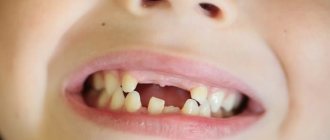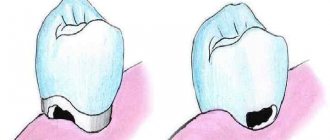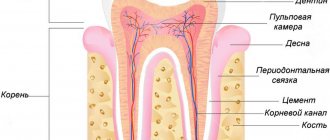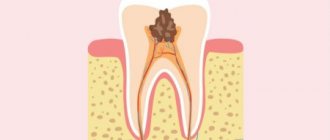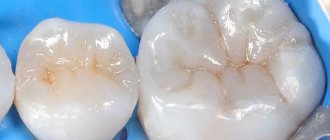1289
Long gone is the era when caries treatment was an unpleasant and painful procedure. In modern cliques you rarely hear a drill that horrifies all its patients.
Today, minimally invasive techniques have begun to be used that involve getting rid of the disease without drilling teeth. One of them is ozone therapy.
general information
The technology of using ozone for the treatment of caries was first introduced in Germany in 2003.
Previously, it was used to treat gingivitis and periodontitis. The essence of the technique is the effect of ozone, which is a strong oxidizing agent, on dental tissues affected by caries.
Due to the high penetrating ability of this substance, pathogenic microflora is destroyed without affecting healthy tissue.
At the same time, the tooth surface is sterilized, which eliminates the recurrence of the disease in the future.
Ozone therapy is most effective when treating the initial stage of caries - in this case, after treating the tooth surface with a triatomic oxygen compound, remineralization is sufficient.
If there are large carious cavities, the dentist may need to widen them and remove the affected tissue, after which ozone treatment and filling material are applied.
METHOD 3: Laser treatment of dental caries (Laser treatment of caries)
This treatment uses laser radiation. Modern dentists have several laser systems in their arsenal. They differ in the source of laser radiation.
A laser beam directed at the tooth will evaporate the areas affected by the carious process.
The procedure is based on the principle of selective photothermolysis: the laser unit is configured in such a way that it burns only dark areas of the enamel and dentin of the tooth, which are pigmented as a result of caries damage.
Healthy tissues do not have a brown color and are therefore not affected.
Simultaneously with the evaporation of the affected area of the tooth tissue, laser radiation stops the growth and reproduction of pathogenic microflora on the carious tooth. The technique is completely non-contact, as a result of which infection of the patient with diseases such as HIV and Hepatitis B and C is excluded.
However, the use of laser techniques is limited by the cost of the laser unit (10-12 million rubles) and the possibility of overheating of tooth tissues with the occurrence of pulpitis.
The technique requires anesthesia before laser treatment of the tooth.
How is ozone used in modern dental practice?
Triatomic oxygen, called ozone, has found quite wide application in medicine, in particular in dentistry. The gas has excellent oxidizing properties, which makes it almost a panacea in many branches of medicine. Special techniques and devices were developed, thanks to which dental therapy took several progressive steps. Humanity owes them to the discoveries that were made in Germany.
Ozone therapy techniques involve the introduction of a pressure jet of ozone into the oral cavity and on the surface of the teeth, destroying bacteria, which helps get rid of inflammation. Another positive point: tooth enamel stops decomposing, and this is extremely difficult to achieve by other methods.
All this suggests that surgical intervention in dentistry is gradually being reduced to minimal manipulations and procedures. Ozone is an effective property in the treatment of such dental ailments:
- caries;
- periodontitis;
- phlegmon.
This gas also perfectly disinfects instruments, implants, prostheses, and helps to heal various wound surfaces faster.
In less than half a minute, you are no longer afraid of pathogenic viruses and microbes that encourage the development of caries. Moreover, all manipulations occur absolutely painlessly. Complications are completely excluded.
How does ozone work?
If periodontal disease is detected in its early stages, ozone removes the infection, improves blood circulation and accelerates healing.
As a prophylactic agent, ozone is used to treat the oral cavity, which removes bacteria and the unpleasant odor they cause. Works wonderfully against inflammatory processes in the oral mucosa.
Those who can compare the treatment of caries using an old, but not always good, drill and a stream of triatomic oxygen are especially grateful to the technique. If using drills it was necessary to drill out the entire damaged surface, and then fill the resulting gap with a cementitious composition. Now a silicone crown is attached to the tooth and ozone is supplied, which destroys microbes. Of course, this method is acceptable if caries has not yet eaten away the enamel before forming a hole. Otherwise, ozone will no longer help. After such a procedure for “ozonizing” caries, you should visit the dentist once every six months to avoid the formation of recurrent caries.
But what to do if caries has already done its rotten work and there is still a hole? In this case, ozone can reduce the specialist’s working time. The sequence of actions will be as follows:
- disinfection;
- removing damaged tissue with a drill;
- filling.
Ozone will act as an analgesic and anesthetic.
If you read an advertisement that completely promises to get rid of caries exclusively with an ozone jet, remember that this is only possible in the first and second stages of caries attack on the tooth.
This is interesting: Review of the best ointments that will help with stomatitis in the mouth of a child and an adult
Main condition
Gentle methods can be used in the early stages of the carious process - that is, when the enamel layer and only a little dentin are damaged. If the lesion has penetrated deep into the body of the unit, then treating caries without drilling the teeth will no longer work.
- The stain stage is when the enamel is just softening and becoming porous, but there is no cavity yet.
- Enamel caries – without affecting dentin.
If you are afraid of the drill, then visit the dentist regularly so that you can receive qualified preventive care and strengthen your teeth.
In what cases will ozone dental treatment help?
- HealOzone root canal disinfection quickly eliminates bacteria, reducing the risk of recurrence of the disease
- Caries in the spot stage During treatment, we use ozone therapy in conjunction with the DIAGNOdent device. This approach allows you to find all the foci of caries and stop them at an early stage.
- Treatment of diseases of the gums, oral mucosa and lips After the first procedure, you will notice that the condition of your gums has improved, bleeding and inflammation will decrease
During endodontic treatment, it is very important not only to eliminate microbes, but also to carefully restore the anatomy of the tooth. Our dentist-therapist Naira Samvelovna Panosyan completed a course in aesthetic restoration and successfully applies this knowledge in practice. The doctor will precisely restore the shape of your tooth after treatment, and it will look healthy.
The decision to use ozone therapy in our clinic is made only after a thorough examination. You will have your initial appointment with the head physician, Davoyan Artashes Eduardovich. He diagnoses the oral cavity and prescribes further treatment, referring you to our other specialists. Come to one of the Happy Dents clinics, on Leninsky Prospekt or Academician Tupolev Street, for dental treatment using modern techniques.
Features of caries treatment with ozone
The essence of the technique is the disinfection of tissues affected by caries. As a result of the action of ozone, the process of destroying pathogenic bacteria occurs; therapy is carried out using a special apparatus that converts oxygen into ozone.
The treatment procedure does not involve the use of a drill to prepare teeth, but if caries affects the dentin and a hole has already formed in the enamel, then it will have to be slightly expanded, and this is not possible without drilling. A drill should also be used in cases where significant destruction of soft tissue is diagnosed. In such a situation, drilling cannot be avoided, since otherwise it will be impossible to install the filling material.
What is ozonation?
Ozonation is a method that uses the powerful oxidizing properties of ozone. First, a test is performed using a diagnostic laser to accurately identify the tissue affected by caries. Laser diagnostics allows you to detect the disease before symptoms appear that require traditional treatment. Then ozonation is used. Oxygen is taken from the air through a device called an ozonizer and then converted into ozone, which is applied to the treated teeth using a special sleeve. The procedure lasts only a few seconds, and its results are completely satisfying - ozone allows you to remove up to 99.9% of bacteria that cause caries. To achieve optimal effect, patients are given drugs to stimulate enamel remineralization. The entire process of hardening and remineralization in the case of caries takes about 4-12 weeks. However, it should be remembered that ozone therapy is effective only for initial lesions. This is why follow-up visits are so important.
Equipment used
To treat caries using ozone therapy, modern dental practice uses special equipment - a German-made Heal Ozone device or one of its analogues.
The essence of the device is as follows:
- Medical oxygen is supplied from a high-pressure oxygen cylinder to the gas supply system;
- in the generator of the device it is converted into ozone;
- A special hose supplies ozone to a silicone tip attached to the problem unit.
Strong fixation of the tip on the patient’s jaw row element is achieved thanks to a vacuum pump that creates negative pressure.
This ensures the safety of the procedure and eliminates the possibility of gas entering the oral cavity.
The concentration of ozone and the duration of its effect on the tooth are determined individually in each clinical case, and are monitored using a special pressure sensor.
Price
Modern treatment technologies mean expensive dental services. The main reasons for this price are the high cost of the equipment and materials used, as well as the increased requirement for specialist qualifications.
It is difficult to name the exact cost of caries treatment services using one of the named methods. The numbers will depend on the pricing policy of the clinic, its status, level of qualifications and training of the doctor. So, treatment:
- ozone therapy will cost from 1,000 rubles. up to 1500 rub. for a tooth;
- ICON – from 2,000 to 5,000 rubles;
- laser – 2500-5000 thousand rubles.
The video provides additional information on the topic of the article.
Indications and contraindications
The ozone therapy method is quite common in dental practice, as it can effectively combat a large number of oral diseases.
In the treatment of dental caries, the use of gas will be effective in the following cases:
- caries in the spot stage;
- early stage carious lesions;
- damage to dental fissures;
- presence of enamel cracks;
- viral and fungal infections of elements of the jaw rows;
- cavities in teeth that require treatment before filling;
- root canal pathologies.
Experts note that, despite the effectiveness of treating affected tissues with ozone, large areas of damage may require their removal with further filling.
And in the case of destruction of an element of the jaw arch by 2/3 or more with simultaneous damage to the root system, it is most advisable to perform extraction and prosthetics.
There are also absolute contraindications to ozone therapy, in the presence of which the specialist will categorically refuse to carry out the procedure.
These include the following patient health conditions:
- blood clotting disorder;
- thyroid dysfunction;
- severe nervous system disorders;
- chronically low blood pressure;
- ozone intolerance;
- seizures;
- intoxication of the body with alcohol, chemicals or medications.
Pros and cons of the method
Among the advantages of the method, dentists highlight the following points:
- absolute hypoallergenic;
- high-quality sterilization of dental tissues, preventing the possibility of repeated damage by pathogenic microorganisms;
- no need to remove dental tissues with minimal damage;
- high speed of the procedure;
- absence of discomfort and pain during dental treatment;
- safety of the manipulation, since if the seal of the silicone nozzle is accidentally broken, the supply of ozone stops.
This is interesting: How to treat a fistula on the gums in an adult and a child at home and in dentistry
The safety and non-contact nature of the ozone therapy technique allows it to be used for the treatment of caries not only in adults, but also in children whose bite is just forming.
There are also disadvantages to ozone therapy for caries. The most significant among them are the following points:
- the impossibility of treating medium and deep caries without removing the affected tissue;
- lack of conditions for high-quality fixation of the filling while preserving softened tissues;
- high cost of the procedure.
Preparatory activities
The decision on the possibility of carrying out the procedure is made on the basis of an examination of the patient’s oral cavity conducted by a specialist.
It includes a visual assessment of the condition of the elements of the jaw row, as well as a study of the anamnesis, which makes it possible to identify diseases that may be a contraindication to the manipulation.
In addition, radiography may be required - this research method will determine the extent of damage to dental tissues.
In the absence of contraindications, the specialist performs professional cleaning of the jaw row from mineralized deposits and carries out the planned treatment of caries.
In the presence of deep carious cavities, preliminary removal of the affected tissues using standard dental instruments is required.
Technique
Treatment of the dental surface with ozone is absolutely painless and therefore does not require prior anesthesia.
It is carried out as follows:
- a special silicone pad is placed on the tooth requiring treatment, which is connected through a hose to an ozone supply device;
- using a special component of the device, a vacuum is created under the cap by pumping out air, which increases the seal of the lining and prevents gas leakage;
- the power key is pressed on the device, which starts the supply of ozone to the problematic element;
- after 20-30 seconds, the gas supply is turned off and the cap is removed from the patient’s tooth.
The completion of the procedure is surface remineralization - coating the treated fragment with a special composition containing micro- and macroelements that increase the strength of the enamel and protect it from the effects of pathogenic microflora.
Features of therapy in children
Carious lesions of teeth in primary occlusion are quite common. The main problem in eliminating it is children's fear of dentists and the undesirability of using anesthesia.
Treatment of caries of primary teeth with ozone is absolutely safe and does not cause any discomfort in young patients.
The only requirement in this situation is superficial damage to the tooth surface, since in the presence of softened tissues and deep cavities it will not be possible to do without filling.
The technology for performing the procedure in children is no different from ozone therapy in adults. A cap of a suitable size is attached to the surface of the affected tooth, after which the gas supply is turned on.
Under the influence of ozone, all pathogenic microorganisms present on the enamel are destroyed, which prevents further damage to the tissue.
Subsequent remineralization of the enamel contributes to its saturation with the necessary mineral components, which reduce susceptibility to external influences and increase the strength of the dental shell.
Advantages and disadvantages of the method
In dentistry, ozone therapy is the most painless, effective and safe non-invasive method. It is ideal for eliminating initial caries, where there is no need for anesthesia, preparation and filling of dental tissues.
The following characteristics are indicated as advantages:
- applicable in pediatric dentistry;
- high sterility due to non-contact;
- does not lead to allergies and is suitable for all patients;
- sterilization of the tooth is complete, which means that re-infection and secondary manifestations of the disease are not allowed;
- the treatment takes place quickly, and there is not even any discomfort;
- no side effects;
- serves as the prevention of caries, since the enamel is additionally strengthened.
The device that produces ozone is absolutely safe and does not pollute the environment, which is important in modern conditions.
The disadvantages of ozonation are the following facts:
- The high cost of treatment due to the high cost of equipment.
- Only superficial caries can be cured without filling.
- Unsatisfactory conditions for fixing a permanent filling, since soft enamel and dentin tissue are not removed.
However, these disadvantages do not affect the overall result of the procedure.
What is the therapeutic effect of ozonation based on?
The key feature of ozone is its instability, due to which this gaseous compound can easily interact with other elements. An important property of ozone is its ability to act as a powerful oxidizing agent, which implies excellent antibacterial properties of the substance. Peroxides, which are formed as a result of oxidation, are destructive to all harmful microorganisms known to science. Ozone can be used not only to combat caries, but also to treat other diseases, for example, stomatitis or gum disease. With its help, you can treat dental canals and combat increased sensitivity of teeth, among other things.
Alternative methods
Treatment of dental caries without drilling the affected units has become widely practiced in dental clinics. In addition to ozone therapy, ICON technology and laser have found their application.
Laser Application
The procedure is carried out using a laser machine, without direct contact with the diseased unit.
The laser beam has a selective effect, i.e. it does not touch “healthy” tissues. Under its action, infected tissues evaporate and pathogenic bacteria die.
The technique has its advantages over classical therapy:
- There is no tissue heating or vibration, which causes discomfort and pain.
- There is no need to inject an anesthetic as the process is painless.
- There is no psychological discomfort associated with the operation of the drill.
- The method is indicated for use in any age group of patients, including children.
- It takes place faster than conventional treatment.
- Prevents secondary manifestations of caries.
- The laser does not damage healthy neighboring tissues.
The disadvantages of laser treatment include the following facts:
- High cost due to the high cost of equipment.
- Working with the equipment requires special training from a doctor, which also affects the overall cost.
- The difficulty of performing the manipulation due to the inevitability of working in darkened glasses, which deteriorates the view of the operated field.
- The laser is used only for cleaning out superficial lesions, but is not suitable for cleaning deep cavities.
- There is a risk of the filling falling out due to the heating of dental tissue by the beam.
Lasers are used in dentistry not only in the fight against caries. It is used for diagnostics and surgical operations.
ICON treatment
This method appeared 10 years ago and is an alternative to remineralization. Allows you to cope with caries at its initial stage.
Icon is the name of a new polymer material that fills shallow grooves and pores in enamel.
The features of the method include the following characteristics:
- The treatment takes place without a drill.
- The method is non-traumatic, absolutely safe, and does not involve the introduction of anesthesia.
- The speed of the procedure is high (it takes 15-20 minutes per affected unit).
- The area treated with polymer is visually no different from the natural elements of the jaw arch.
The essence of the process comes down to etching the affected tooth surface with hydrochloric acid. To prevent the acid from touching the gums and healthy tissues, they are covered with a latex protective plate. After cleaning, the cavity is filled with polymer.
Disadvantages of ICON treatment:
- Not intended for dentin.
- It costs more than the classical method.
- Application requires special training and a certain level of knowledge from the dentist.
Possible complications
No special complications after ozonation were observed in dental practice. In a separate category of patients the following were noted:
- mild headache;
- mild irritation of the mucous membrane;
- change in the depth and rhythm of breathing.
This is interesting: Oral hygiene index and methods for determining it in children and adults: PMA, KPU, Navi index, etc.
Dentists associate the likelihood of severe consequences with the presence of diseases that the patient hid during the consultation.
Reviews
Reviews about ozonation are for the most part only positive. Many patients were able to appreciate the safety, painlessness, and most importantly - the effectiveness of the procedure, which can cope with caries quickly.
If you have similar treatment experience and would like to express your opinion about the effectiveness of this procedure, please share your feedback in the comments to this article.
If you find an error, please select a piece of text and press Ctrl+Enter.
Tags caries treatment treatment of caries with ozone
Did you like the article? stay tuned
Previous article
Features of teeth whitening with Double White products
Next article
Collagen membrane is a natural, effective and safe product
Ozone therapy in the treatment of periodontitis
Ozone improves blood circulation, normalizes the microflora of the oral cavity, suppresses pain, bleeding, and swelling. Ozone therapy is often used in the treatment of periodontitis in combination with other methods.
Our specialists offer patients several ways to use ozone:
- ozonated oil applications;
- rinsing the mouth with ozonated distilled water;
- introduction of ozone-air mixture.
You can use the first two methods yourself, at home. But the introduction of a gas mixture into the gum pockets is carried out only in the dentist’s chair. The full course consists of 5–10 procedures.
Ozone therapy makes it possible to dramatically increase the effectiveness of treatment and restoration of gums; it has proven itself both as an independent method of therapy and as a supporting agent in combination with other methods. Let's list some advantages of this method.
Price
The cost of the procedure is determined transparently at the Mane Clinic dental center. We don't have any hidden fees. You can always perform ozone treatment at the most affordable cost - the price for ozonation of baby teeth at the Mane Clinic is available to all patients and is not high. On average, it ranges from 1000 – 3500 rubles.
By contacting our dental center in Moscow for help, you will always receive prompt assistance from the best dentists.
Our specialists have sufficient experience and will perform all necessary procedures competently and professionally. Bring your child to us and we will help maintain the health of his teeth and oral cavity.
How the HealOzone device works
Under the influence of current, the oxygen entering the HealOzone device is converted into ozone. The gas effectively eliminates pathogenic microflora and does not irritate soft tissues.
How is ozone therapy performed?
The doctor brings the tip of the device to the tooth cavity or soft tissues and delivers ozone through the silicone cap. The gas operates for 30–40 seconds, during which time it sterilizes the selected area. Ozone eliminates up to 90% of pathogenic bacteria, thereby restoring the health of your tooth.
Ozone therapy in our clinic is used as part of complex treatment of teeth and gums. Ozone is harmless in a clinical situation; no contraindications to the procedure have been identified. The gas does not cause an allergic reaction. Make an appointment at the Happy Dents clinic (South-Western Administrative District) for safe and comfortable dental treatment with ozone.
Medical Internet conferences
Ozone is an unstable gaseous compound consisting of three oxygen atoms.
It is formed from an oxygen molecule by exposure to radiation (oxygen breaks down into two atoms that interact with molecular oxygen, forming an ozone molecule); decomposes into molecular and atomic oxygen. The ozone molecule is more unstable compared to molecular oxygen and, as a result, easily reacts with other elements and has the greatest oxidative activity: [2; 6].
This feature of ozone determines its sterilizing and antibacterial ability. Namely, the released highly active oxygen radicals oxidize unsaturated fatty acids and lipids in the membranes of pathological cells and lead to the formation of peroxides - substances harmful to pathogenic microorganisms. Thus, in the process of oxidative reactions, the cell membrane and, accordingly, the cell itself are destroyed.
Ozone has an antiseptic effect against all known viruses, bacteria, fungi, spores, cysts, since they have a cell membrane that is weakly resistant to the action of an oxidizing agent and lack a protective cholesterol layer and cellular enzymes; they do not have hereditary resistance to this oxidizing agent.
Ozone has a selective effect against pathologically altered cells of the body, but only at a certain specified concentration of the substance and the duration of its exposure: [1; 5].
Based on the above, based on ozone, the German company KaVo has developed the HealOzone device, which can be used for the treatment of caries (initial, superficial, medium, deep), dental hypersensitivity, disinfection of root canals after their endodontic treatment, inflammatory lesions of the oral mucosa (herpes, stomatitis).
The most effective and frequently used device is HealOzone for the treatment of caries. Since it destroys 99.9% of all cariogenic microorganisms, protein structures that counteract remineralization, neutralizes acidic metabolic products of bacteria (lactic, pyruvic acids), enhances the natural mineralization of hard tooth tissues due to its oxidizing potential with the help of minerals contained in saliva calcium and phosphorus, preventing relapse of caries: [3; 4].
Ozone is supplied to the affected tooth through a soft silicone cap (the HealOzone system kit includes 50 disposable caps ranging in size from 3 to 8 mm). They do not frighten the little patient either by sound or sight. A flexible transparent cap is attached to a special tip, into which strictly dosed portions of ozone are supplied through a hose from the device. Under the cap, a pressure below atmospheric pressure is created, so the cap seems to stick to the tooth, and a complete seal is created, allowing for absolutely safe treatment, excluding the ingress of ozone into the surrounding tissues and the inhalation of gas by the patient. In just 20-30 seconds, ozone makes the tooth almost sterile, preventing the destruction of enamel. In most cases, it is enough to perform the procedure once and then repeat every 6 months.
After the procedure, remineralizing therapy of hard dental tissues is mandatory: the treated surfaces are moistened with HealOzone restorative liquid, which enhances mineralization and lowers pH, its components are xylitol, sodium benzoate, sodium fluoride, citric acid, methyl paraben, water; It is recommended to use the HealOzone kit for the patient daily for 4-6 weeks, ensuring a reliable supply of remineralizing substances over a long period of time through the use of the following products: toothpaste (used 2 times a day), mouthwash (used 2-3 times a day). day after meals), oral spray (also 2-3 times a day). Ingredients: high concentration of sodium fluoride, phosphates and calcium.
Operating principle of the HealOzone device:
1. Air dehumidifier. Atmospheric air is drawn in through the air intake. The dehumidifier has an automatic moisture sensor that keeps the humidity at a constant level, thereby ensuring an even concentration of ozone in the nozzle.
2. Differential pressure sensor. A sensor that regulates ozone leakage and activation of the ozone generator. Creates pressure in the nozzle below atmospheric pressure.
3. Closed ozone generator. This system produces ozone from oxygen. contained in the air.
4. Tip.
5. Moisture trap.
Prevents moisture from seeping into the ozone neutralizer. Since in the presence of moisture, the ozone molecule is difficult to destroy.
6. Ozone neutralizer. Converts ozone back to oxygen at the end of treatment and releases it as molecular oxygen back into the air.
7. Vacuum pump. The vacuum pump prevents ozone from leaking from the system.
The concentration of ozone in water for caries treatment in the handpiece cap is 2100 ppm at a rate of 100 times per second. But it can also be adjusted from 10 to 100 micrograms per 1 milliliter of water, depending on the needs for a particular dental procedure.
Benefits of treating caries in children with ozone using the HealOzone device.
There is no allergic reaction to ozone. Does not irritate the oral mucosa. Does not change tooth color. Promotes mineralization of hard tooth tissues. The ozone reaction occurs 3500 times faster than the reaction of liquid compounds. Treatment takes much less time than other methods. There are no toxins after treatment, and the formation of carcinogenic substances, such as the synthesis of dioxin during chlorination, is excluded. The ozone molecule has a small size, so it quickly penetrates into the infected tooth tissue, which ensures complete sterilization and a positive result in the treatment of caries. Does not require special skills to use: [1].
Today in dentistry, modern methods of remineralizing therapy, ozone therapy, and Icon are used in dentistry to treat initial caries. A comparative analysis was carried out between the methods of treating initial caries using the HealOzone, Icon systems and silver preparations.
Operating principle of Prozone
The Prozone device produces ozone, a gas that promotes faster healing of wounds and treatment of infections. Prozone has a powerful antibacterial effect without the use of antibiotics. The used ozone immediately after treatment decomposes to form oxygen.
Areas of use:
PREVENTION
- disinfection of the tooth crown before sealing fissures in children
- disinfection of periodontal pockets during professional cleaning
THERAPY
- disinfection of the root canal in the treatment of pulpitis and periodontitis
- treatment of the oral mucosa
- periodontitis treatment
- sterilization of carious cavity
SURGERY
- treatment of the wound after tooth extraction to speed up healing
- implant processing for speedy engraftment
- disinfection of wounds when applying sutures
ORTHOPEDICS
- disinfection of gum tissue before fixing crowns and orthopedic structures
CHILDREN'S DENTISTRY
- sterilization of the tooth before treatment of multiple caries
- treatment of herpes and stomatitis
- disinfection of the surface of teeth under braces
Application of ozone in other areas of dentistry
Due to its strong disinfecting properties, ozone is widely used in the field of dentistry, in which the elimination of pathogenic microorganisms determines the success of treatment. In addition to antibacterial, antifungal and antiviral effects, ozone increases the degree of oxygenation of tissues, thereby accelerating their regeneration. Ozonation is used in orthodontics to eliminate microbes from infected root canals. Ozone, due to its gas form, is able to penetrate into the smallest gaps of the complex root canal system and effectively disinfect them. This reduces the risk of secondary infections while accelerating periapical healing. The use of ozone can often eliminate the need for anastasia.
Application of ozone in surgery
Ozone is also used in dental surgery, for example, to disinfect alveoli after tooth extraction or to treat difficult-to-heal wounds. Ozone therapy reduces pain after surgery and accelerates wound healing. In the field of periodontics and dentistry dealing with the treatment of gum disease, ozone allows for precise disinfection of gum pockets and mucous membranes.
Sources:
- https://zubovv.ru/lechenie/zubyi/karies/ispolzovanie-ozona-bez-bormashinyi.html
- https://MositalDent.ru/ozon-v-stomatologii/
- https://happydents.ru/uslugi/lechenie-zubov/lechenie-ozonom-heal-ozon/
- https://mnogozubov.ru/lechenie-kariesa-ozonom/
- https://www.vash-dentist.ru/lechenie/zubyi/karies/beskontaktnoe-ozonom.html
- https://superdentos.ru/cat/parodontologija/ozonoterapija
- https://denta.kdpmc.ru/lechenie-desen/lechenie-desen-ozonoterapiej/
- https://stomat32.ru/2019/08/13/ozon-v-stomatologii/






